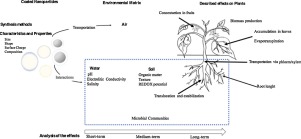Journal of Hazardous Materials ( IF 12.2 ) Pub Date : 2017-12-25 , DOI: 10.1016/j.jhazmat.2017.12.058 Martha L. López-Moreno , Yarilyn Cedeño-Mattei , Sonia Janet Bailón-Ruiz , Edgar Vazquez-Nuñez , José A. Hernandez-Viezcas , Oscar Juan Perales-Pérez , Guadalupe De la Rosa , José R. Peralta-Videa , Jorge L. Gardea-Torresdey

|
The application of nanomaterials (NMs) depends on several characteristics, including polydispersity, shape, surface charge, and composition, among others. However, the specific surface properties of bare NMs induce aggregation, reducing their utilization. Thus, different surface coverages have been developed to avoid or minimize NMs aggregation, making them more stable for the envisioned applications. Carbon-based NMs are usually coated with metals, while metal-based NMs are coated with natural organic compounds including chitosan, dextran, alginate, or citric acid. On the other hand, the coating process is expected to modify the surface properties of the NMs; several coating agents add negative or positive charges to the particles, changing their interaction with the environment. In this review, we analyze the most recent literature about coating processes and the behavior of coated NMs in soil, water, and plants. In particular, the behavior of the most commercialized metal-based NMs, such as TiO2, ZnO, CeO2, CuO, Ag, and Au, and carbon-based NMs are discussed in this review. The available articles about the effects of coated NMs in plants are discussed. Up to now, there is no uniformity in the information to ensure that the surface coverage increases or decreases the effects of NMs in plants. While some parameters are increased, others are decreased. Since the data is contradictory in some cases, the available literature does not allow researchers to determine what concentrations benefit the plants. This review highlights current results and future perspectives on the study of the effects of coated NMs in the environment.
中文翻译:

包膜NM的环境行为:理化方面和植物相互作用
纳米材料(NMs)的应用取决于多个特性,包括多分散性,形状,表面电荷和组成等。但是,裸露的NM的比表面特性会引起聚集,从而降低其利用率。因此,已经开发出不同的表面覆盖率来避免或最小化NMs聚集,从而使其对于预期的应用更加稳定。碳基NM通常涂有金属,而金属基NM则涂有天然有机化合物,包括壳聚糖,葡聚糖,藻酸盐或柠檬酸。另一方面,涂层工艺有望改变NMs的表面性能。几种涂层剂会给颗粒添加负电荷或正电荷,从而改变它们与环境的相互作用。在这篇评论中,我们分析了有关涂层过程以及涂层的NM在土壤,水和植物中的行为的最新文献。特别是,最商业化的基于金属的NM(例如TiO)的行为2,本文中讨论了ZnO,CeO 2,CuO,Ag和Au以及碳基NM。讨论了有关包覆型NM在植物中的作用的可用文章。到目前为止,信息的一致性还不足以确保表面覆盖增加或减少植物中NM的影响。虽然某些参数增加了,但其他参数却减少了。由于数据在某些情况下是矛盾的,因此现有文献不允许研究人员确定哪种浓度有益于植物。这篇综述重点介绍了涂层NMs在环境中的影响研究的当前结果和未来观点。









































 京公网安备 11010802027423号
京公网安备 11010802027423号